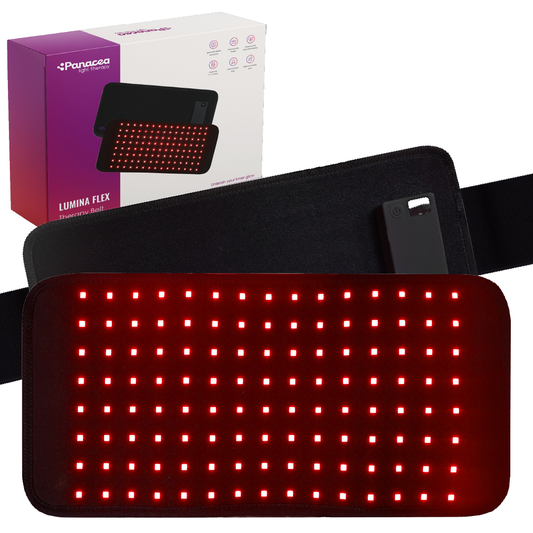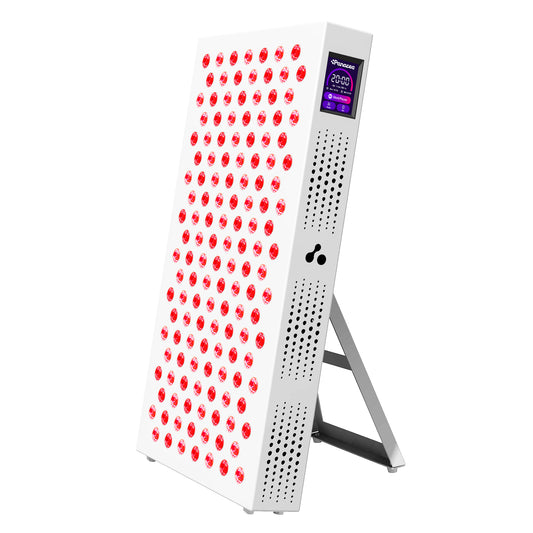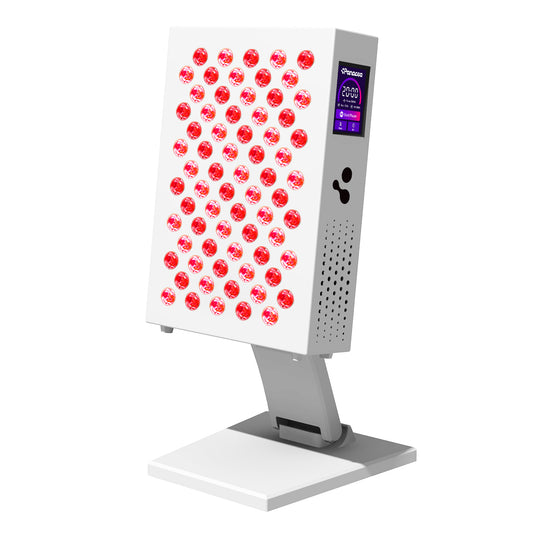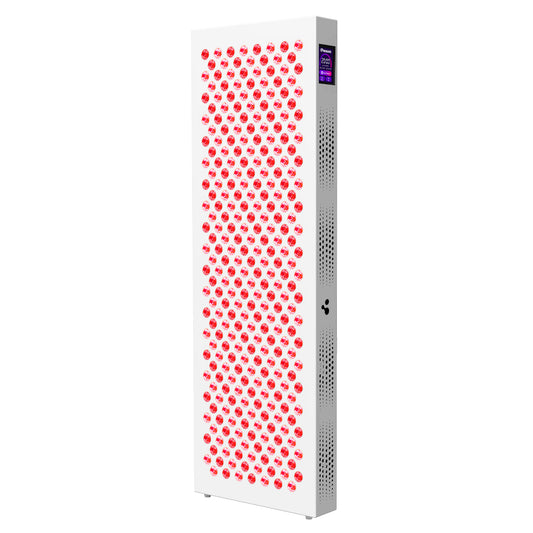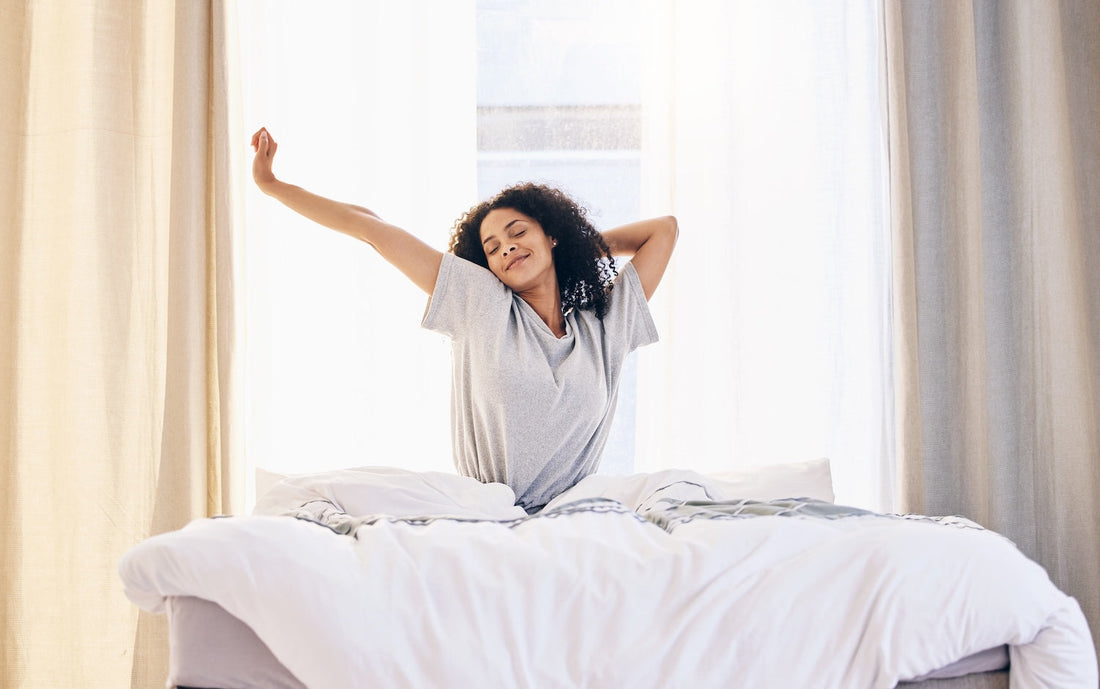
This way you can sleep better and wake up rested
Red Light Therapy and Sleep: How Different Wavelengths Help Improve Recovery
Deep, uninterrupted sleep is essential for a healthy body and a clear mind. More and more people are discovering red light therapy as a natural support for sleep problems, stress and fatigue. But not all red light is the same. Different wavelengths each have a unique effect on the body.
In this article we explain how red and infrared light support sleep, and what the specific effects are of the wavelengths 630 nm, 660 nm, 810 nm, 850 nm, 940 nm and 1060 nm . We refer to relevant scientific studies that substantiate their effects.
Light and the circadian rhythm
Light has a direct influence on the circadian rhythm , also known as the biological clock. Bright white or blue light in the evening can disrupt the production of melatonin , the hormone that makes us sleepy. Red light, on the other hand, and in particular certain wavelengths, can support natural melatonin production and prepare the body for rest.
Melatonin and red light therapy
Melatonin is a hormone produced by the pineal gland in the brain. Its release is strongly influenced by light and darkness. In a natural day-night rhythm, melatonin production increases as soon as it starts to get dark outside. This makes us sleepy and prepares the body for rest and recovery.
Nowadays, however, we are surrounded by artificial light until late at night, especially blue light from screens and bright indoor lighting. These forms of light suppress melatonin production, making it harder to fall asleep or sleep deeply.
Red light, on the other hand, especially in the 630 nm to 660 nm range, has no melatonin-suppressing effect. In fact, research shows that red light can actually stimulate increased melatonin release when applied at the right time of day.
In a study conducted among female basketball players, sleep quality improved significantly after just two weeks of daily use of red light therapy in the evening hours. An increase in melatonin levels was also measured.
Study: Red Light Increases Melatonin, Improves Sleep
This makes red light therapy particularly valuable for people who suffer from:
- Difficulty falling asleep
- Irregular working hours (such as shift work)
- Jet lag or disrupted biological clock
- Sleep Problems Caused by Excessive Screen Time
When combined with avoiding blue light in the evening and a consistent sleep routine, red light therapy can help naturally restore your hormonal sleep cycle , without medication or side effects.
The effect of the different wavelengths
630 nm – superficial skin stimulation
- Application : Works in the upper layers of the skin
- Effect : Supports collagen formation, skin repair and wound healing
- Relevance to sleep : By relaxing the skin and reducing tension in the face, this wavelength contributes to overall relaxation.
- Research: effect on collagen production
660 nm – cell repair and inflammation inhibition
- Application : Penetrates deeper into skin and tissues.
- Effect : Improves blood circulation, stimulates mitochondrial energy production (ATP) and reduces inflammation.
- Relevance for sleep : Supports recovery processes during sleep, promotes physical relaxation.
- Research: Mitochondrial Stimulation and Recovery
810 nm – neurological support
- Application : Can penetrate brain tissue via transcranial application.
- Effect : Supports cognitive function, improves mood, and reduces stress and anxiety.
- Relevance to sleep : Helps with mental unrest and insomnia related to stress or overstimulation.
- Research: 810 nm and brain function
850nm – deep muscle and tissue recovery
- Application : Penetrates deeply into muscles, joints and organs.
- Effect : Stimulates tissue repair, increases oxygen uptake and supports energy metabolism.
- Relevance for sleep : Ideal for physical fatigue or muscle pain after exertion; promotes deep recovery during the night.
- Research: muscle recovery with infrared light
940 nm – thermal effect via water absorption
- Application : Highly absorbed by water in body tissues.
- Effect : Activates heat transfer, relaxes connective tissue and stimulates the lymphatic system.
- Relevance to sleep : Supports deep tissue relaxation and may contribute to a more relaxed body at sleep.
- Research: Thermal effects on tissue
1060 nm – neuroprotection and cognitive optimization
- Application : Penetrates deeply into brain tissue.
- Effect : Supports neuroplasticity, improves memory and slows age-related cognitive decline.
- Relevance to sleep : Promotes deep rest in people with mental unrest or age-related sleep problems.
- Research: 1060 nm in cognitive processes
Which wavelength suits your sleep goal?
| Wavelength | Main effect | Recommended for |
|---|---|---|
| 630 nm | Superficial relaxation, skin recovery | Tension in the face or skin |
| 660 nm | Cell repair, anti-inflammatory | General recovery, inflammations |
| 810 nm | Mental peace, mood improvement | Stress, mental fatigue |
| 850 nm | Muscle and tissue recovery | Athletes, physical strain |
| 940 nm | Deep relaxation, connective tissue | Chronic tension, restless legs |
| 1060 nm | Cognitive support | Sleep problems in the elderly or brain overstimulation |
When is the right time for red light therapy if you want to sleep better?
The ideal time to use red light therapy to support melatonin production and deeper sleep is in the early evening , approximately 30 to 90 minutes before bedtime .
Why?
- During this phase, your body naturally begins to prepare for rest.
- By providing exposure to non-stimulating light (such as red or near-infrared light) at this time, you support this transition to night.
- At the same time, you avoid the negative effects of blue light, which actually blocks melatonin production.
Sample routine :
- Are you going to bed at 22:30? Then you can use the red light therapy between 21:00 and 22:00 .
- A session of 10 to 20 minutes is already effective, depending on the strength of the lamp and the distance to the skin.
NB:
Are you using a lamp with infrared wavelengths (such as 850 nm or 1060 nm) ? Then you can also use it a little earlier in the day, for example late in the afternoon, to bring the body into a recovery mode — without directly affecting the melatonin.

